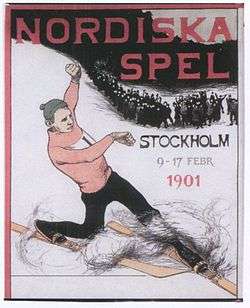Nordic Games

The Nordic Games was the first international multi-sport event that focused primarily on winter sports, and was held at varying intervals between 1901 and 1926. It was organized by Sweden’s Central Association for the Promotion of Sports,[1] and more specifically by Viktor Balck, a member of that association and one of the five original members of the International Olympic Committee. It was, in many ways, a precursor to the modern Winter Olympic Games,[2] whose success was a contributing factor (along with the social and economic turmoil following World War I) to the Nordic Games's discontinuation in the 1920s.[1]
The Nordic Games began in Stockholm, Sweden in February 1901, after being conceived in 1899 by the Swedish Central Association for the Promotion of Sports (SCFIF) led by Viktor Balck, a well-known Swedish sports figure. He is quoted as saying, “Above all we placed the national goal of rendering a service to the fatherland and bringing honor to our country.” The Nordic Games have now become a national concern for our entire people.” They were held every four years thereafter through 1926. Many believe that this event led to the implementation of the Winter Olympics as we know them today. The Nordic Games began as an effort to bolster both Swedish National sentiment along with Swedish tourism. The Nordic Games featured not only the snow and ice related sports that the country excelled in but also showcased Swedish cultural events such as thereafter, opera and folklore. The beautiful countryside and tourist attractions were also highlighted
History
The Nordic Games began in Stockholm, Sweden in February 1901, after being conceived in 1899 by the Swedish Central Association for the Promotion of Sports (SCFIF) led by Viktor Balck, a well-known Swedish sports figure. He is quoted as saying, “Above all we placed the national goal of rendering a service to the fatherland and bringing honor to our country.” The Nordic Games have now become a national concern for our entire people.” They were held every four years thereafter through 1926. Many believe that this event led to the implementation of the Winter Olympics as we know them today. The Nordic Games began as an effort to bolster both Swedish National sentiment along with Swedish tourism. The Nordic Games featured not only the snow and ice related sports that the country excelled in but also showcased Swedish cultural events such as thereafter, opera and folklore. The beautiful countryside and tourist attractions were also highlighted.
Sports
The Nordic Games consisted of the winter sports that were popular in Scandinavia at the time, such as ski jumping, downhill racing, cross-country skiing, skeleton, speed skating, figure skating, ice hockey and curling. Some non-winter sports were also included like fencing, swimming and a long-distance equestrian ride. Many other winter sports that we think of as strange today were also played. These included skeleton, sledding behind horses, hunting, skiing behind reindeers, military sports, car racing, motorcycle racing, ballooning, kick-sled, and pulka racing.
Ties to Winter Olympics
The Nordic Games were one of the first to lead to international championships in winter sports. For example, the skating championships raised the international appeal of the Nordic Games. Viktor Balck, the founder of the Nordic Games, was also a charter member of the International Olympic Committee and a President of the International Skating Union. He is credited with holding the ISU together through the end of World War I. He also established the World Championship Events for Ladies and Pairs, who were not recognized before this. Balk was known as the ISU President with the longest tenure of 30 years of any President before him. He was elected the first honorary President of the ISU. All of his participation helped the Olympics take hold. The Winter Olympics as we know it today began in Chamonix, France in 1924. Prior to this time, some winter sports such as figure skating an ice hockey were held during the summer Olympics.
Decline
The Nordic Games mainly included only competitors from the Scandinavian countries of Denmark, Finland, Iceland, Sweden, and Norway. These countries ended up opposing the establishment of a separate Winter Olympics because it would take away from their nationalistic efforts. Sweden and Norway had political differences during this time which led Norway to not participate in the games, which caused some controversy. After Viktor Balck died in 1928, there was no one to champion the cause, especially after the 1930 games had to be canceled due to lack of snow. The Olympics turned out to be highly successful right from the beginning and their international appeal overshadowed the Nordic Games.
References
- 1 2 SCIF: "Nordiska spelen" (in Swedish), retrieved February 1, 2015
- ↑ Swedensport: " The Nordic Games ", retrieved February 1, 2015